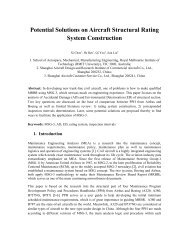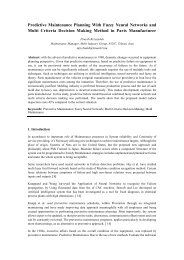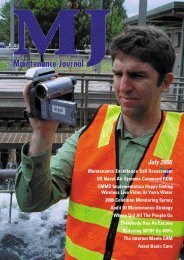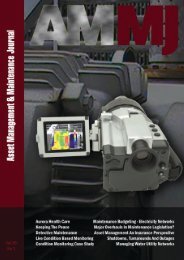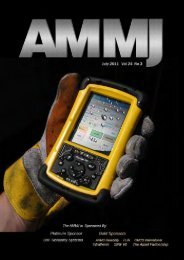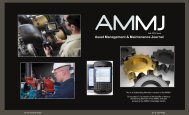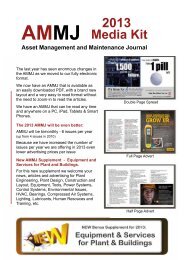<strong>AMMJ</strong>DSM Planning and Scheduling 54to column 2.5. <strong>The</strong>se tasks willform another block in the matrixas shown in Figure 6.Figure 6<strong>The</strong> Final Partitioned Matrix2. Powers of the AdjacencyMatrix MethodWe convert the active matrix asshown in Figure 5 into a binarymatrix by replacing the “X” marksby “1” and all other empty cellswith “0”. Raising the DSM to the4th power reveals that tasks 1.1,1.3, 2.5, 3.3, 3.6, 4.1, 4.2 and 4.3are involved in a 4 step circuit.This is indicated by a “1” entryfor the tasks along the diagonalof the matrix as shown in Figure7. In the resultant square matrix,cells with a value greater thanone are replaced by a value ofone.Raising the matrix to the 5thpower reveals that the DSM isnot involved in any other circuitsindicated by the “0” along thediagonal of the matrix. By usingtrial and error to determine whichtasks are involved in which circuit,we will condense (schedule aftereach other) all the tasks in eachcircuit to form two blocks. <strong>The</strong>first involves tasks 1.1, 1.3, 3.3and 3.6 and the second blockinvolves tasks 2.5, 4.1, 4.2 and4.3. We will convert the binarymatrix back to the active matrixas shown in Figure 6.Figure 7<strong>The</strong> Binary Matrix Raised to the 4 th Power3. Reachability Matrix MethodWe will construct a table asshown in Table 1 listing the inputelements, output elements, theintersection of the input andoutput sets for each elementand the level of hierarchy. Wecan observe from the column ofthe input elements that elements1.2, 3.1, 3.2, 5.1 and 5.2 are inthe top level hierarchy becausethe input values of these elements are equal to the intersection values. We will remove these elements from the tableand continue until we reach the corresponding input & output values as shown in Table 2. We will rearrange the originalDSM, and schedule the elements starting with the top level hierarchy through to the 11th level hierarchy elements asshown in Figure 6. <strong>The</strong> circuits we identified will form two blocks in the DSM. <strong>The</strong> first involves tasks 1.1, 1.3, 3.3, 3.6and the second block involves tasks 2.5, 4.1, 4.2 and 4.3.ConclusionsDSM is a new approach to asset management, used to represent, analyse dependencies among tasks and showthe order in which tasks are preformed. This approach provides a way of managing feedbacks. <strong>The</strong> outcome frompartitioning the DSM is a faster development process that can be done by optimizing the availability of information.From the case study, we can see that the number of feedbacks in the petroleum oil field development project have beenreduced, hence reducing the project cost significantly.In general, the DSM methods can be applied to identify loops/circuits for project planning and scheduling improvement.When the number of tasks involved in the project is small, the Path Searching method can be done effectively. If the projectVol 25 No 1
<strong>AMMJ</strong>DSM Planning and Scheduling 55is more complex, then the Powers of theAdjacency Matrix and the ReachabilityMatrix methods should be implemented.It can be observed from the case studythat the Reachability Matrix method isalso efficient for small projects.References[1] Banerjee, A., Carrillo, E. and Paul, A.(2007). Projects with sequential iteration:Models and complexity. IIE Transactions, Vol.39, No. 5, pp. 453-463.[2] Browning.T.R. (2001). Applying the DesignStructure Matrix to System Decompositionand Integration problems: A Review and NewDirections. IEEE Transactions on EngineeringManagement, pp 292-300.[3] Chen.C, Khoo.L and Jiao.A. (2004).Information deduction approach through qualityfunction deployment for the quantificationof the dependency between design tasks.International Journal of Production Research,Vol 42,pp 4623- 4637.[4] Cho and Eppinger. (2001). Productdevelopment process modeling usingadvanced simulation. Design engineeringtechnical conferences, Pittsburgh, pp 1-9.[5] Danilovic, M. and Browning, T. R. (2007).Managing complex product developmentprojects with design structure matrices andTable 1 Element’s inputs, outputs, intersections and level of hierarchydomain mapping matrices. InternationalJournal of Project Management, April 2007,Vol. 25 No. 3, pp. 300-314.[6[ Eppinger, Whitney, Smith and Gebala.(1994). A Model-Based Method for OrganizingTasks in Product Development. MIT SloanTable 2 Removing the 10School of Management, pp 1-20th level hierachy elements[7] Eppinger and Ulrich. (2003). Product Design and Development. New York McGraw-Hill.[8] Maheswari.J, Varghese.K. (2005). A Structured Approach to Form Dependency Structure Matrix for Construction Projects.International Symposium on Automation and Robotics in Construction, Indian Institute of Technology Madras, pp 1–6.[9] M. E. Sosa. (2008). A Structured Approach to Predicting and Managing Technical Interactions in Software Development. Researchin Engineering Design, Vol. 19, No. 1, pp. 47-70.[10] Mori.T, Kondo.K, Ishii.K and Ohtomi.K. (1999). Task Planning For Product Development by Strategic Scheduling of DesignReviews. ASME Design Engineering Technical Conferences, Las Vegas, pp 1-12. [11] P. Sage and W. B. Rouse. (2009). Handbookof Systems Engineering and Management. Wiley, New York, 2 edition.[12] Steward, D. (1981). <strong>The</strong> Design Structure Matrix: A Method for Managing the Design of Complex Systems. IEEE Transactionson Engineering Management, Vol. 28, No. 3, pp. 71-74.[13] T. R. Browning. (2009). <strong>The</strong> Many Views of a Process: Towards a Process Architecture Framework for Product DevelopmentProcesses. Systems Engineering, Vol. 12, No. 1, pp. 69-90.[14] U. Lindemann, M. Maurer and T. Braun. (2009). Structural Complexity Management - An Approach for the Field of ProductDesign. Springer, Berlin.[15] Yassine.A, Falkenburg.D and Chelst.K. (1999). Engineering design management and information structure approach. InternationalJournal of Production Research, Vol 37 pp 2957 – 2975.[16] Yassine, Whitney and Zambito. (2001). Assessment of Rework Probabilities for Simulating Product Development using theDesign Structure Matrix (DSM). ASME International Design Engineering Technical Conferences, Pennsylvania, pp 1-9.[17] Yassine. A. (2004). An Introduction to Modeling and Analyzing Complex Product Development Processes Using the DesignStructure Matrix (DSM) method. Product development research laboratory, University of Illinois, pp 1-17.Indra Gunawan is a Senior Lecturer and Coordinator of “Postgraduate Programs in <strong>Maintenance</strong> & Reliability Engineering”in the School of Applied Sciences and Engineering at Monash University. He obtained his Ph.D. degree in Industrial Engineeringfrom Northeastern University, USA. His main areas of research are reliability engineering, production and operations management,application of operations research, applied statistics, probability modeling, and project management.Vol 25 No 1




